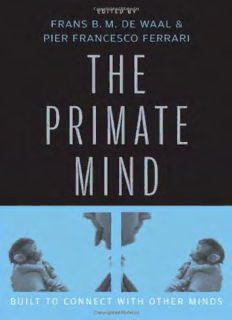
The Primate Mind: Built to Connect with Other Minds PDF
Preview The Primate Mind: Built to Connect with Other Minds
• THE PRIMATE MIND Built to Connect with Other Minds Edited by Frans B. M. de Waal and Pier Francesco Ferrari Harvard University Press Cambridge, Massachusetts, and London, England 2012 Copyright © 2012 by Frans B. M. de Waal and Pier Francesco Ferrari Al! rights reserved Printed in the Uniteci States of America Library of Congress Cataloging-in-Publication Data The primate mind : built to connect with other minds I edited by Frans B. M. de Waal and Pier Francesco Ferrari p. cm. Based on a meeting held June 4-7, 2009, at the Ettore Majorana Center in Erice, Sicily, Italy. Includes bibliographical references and index. ISBN 978-0-674-05804-0 (alk. paper) 1. Primates-Psychology. 2. Socia! psychology. 3. Neuropsychology. 4. Psychology, Comparative. 5. Comparative neurobiology. I. Waal, F. B. M. de (Frans B. M.), 1948- II. Ferrari, Pier Francesco. QL737.P9P67259 2011 599.8'1513-dc23 2011016094 Contents Preface ix Frans B. M. de Waal and Pier Francesco Ferrari 1 A Bottom~Up Approach to the Primate Mind 1 Frans B. M. de Waal and Pier Francesco Ferrari SECTION ONE From Understanding of the Actions of Others to Culture 11 2 The Mirror Neuron System in Monkeys and Its Implications for Social Cognitive Functions 13 Pier Francesco Ferrari and Leonardo Fogassi 3 The Human Mirror Neuron System and Its Role in Imitation and Empathy 32 Marco Iacoboni 4 Socia! Rules and Body Scheme 48 Naotaka Fujii and Atsushi Iriki 5 What, Whom, and How: Selectivity in Socia! Learning 65 Ludwig Huber 6 Learning How to Forage: Socially Biased Individua! Learning and "Niche Construction" in Wild Capuchin Monkeys 81 Elisabetta Visalberghi and Dorothy Fragaszy I vi CONTENTS --~----------~~----~·-····---· 7 Social Learning and Culture in Child and Chimpanzee 99 Lydia M. Hopper, Sarah Marshall-Pescini, and Andrew Whiten SECTION TWO Empathy, Perspective Taking, and Cooperation 119 8 A Bottom-Up View of Empathy 121 Frans B. M. de Waal 9 What Does the Primate Mind Know about Other Minds? A Review of Primates' Understanding of Visual Attention 139 Aprii M. Ruiz and Laurie R. Santos 10 Human Empathy through the Lens of Psychology and Social Neuroscience 158 Tania Singer and Grit Hein 11 How Much of Our Cooperative Behavior Is Human? 175 Brian Hare and Jingzhi Tan 12 Fetal Testosterone in Mind: Human Sex Differences and Autism 194 Bonnie Auyeung and Simon Baron-Cohen SECTION THREE Memory, Emotions, and Communication 209 13 The Role of Broca's Area in Socio-Communicative Processes of Chimpanzees 211 William D. Hopkins and ]ared P. Taglia/ate/a 14 Emotional Engagement: How Chimpanzee Minds Develop 224 KimA. Bard 15 Distress Alleviation in Monkeys and Apes: A Window into the Primate Mind? 246 Filippo Aure/i and Orlaith N. Fraser 16 Enquiries Concerning Chimpanzee Understanding 265 Charles R. Menzel and Emi! W. Menzel Jr. CONTENTS vii ------------- 17 What Is Uniquely Human? A View from Comparative Cognitive Development in Humans and Chimpanzees 288 Tetsuro Matsuzawa I References 307 Contributors 379 Index 381 Preface The Primate Mind seeks to inject the study of primate and human cogni tion with a new perspective, one less concerned with cognitive "rankings" among humans, apes, monkeys, canines, corvids, and other nonprimates, but rather with the nuts and bolts of cognition: the way it works. The focus is on the way the mind interacts with other minds in terms of emo tional and cognitive connections, such as empathy, imitation, cultura! learn ing, and cooperation. Primates are intensely socia!, hence continuously chal lenged to compete with, work with, or understand each other. Their brains have been designed for socia! connection. From June 4 through 7, 2009, about one hundred participants gathered at the Ettore Majorana Center located in Erice, a city on a 750-meter-high mountaintop in Sicily, Italy, with a gorgeous view of the Mediterranean. A curious location given that we like to look at our new approach as a bottom-up perspective! Sixteen prominent speakers (Figure 0.1), who con tributed to the present volume, were asked to cover primate cognition from all possible angles. The challenge was to analyze the cognitive pro cesses underlying socia! interaction, some of which may be very basic and widespread and emerge early in human development, while others may be more advanced, even uniquely human. How do primates perceive and interpret each other's motor actions, how do they perceive and interpret each other's emotional states and situations, and how does this informa tion in turn influence complex socia! interaction? What are the develop mental landmarks of these processes? Are there neural structures and mechanisms that underpin all of them? PREFACE The interaction between neuroscience and primatology (or ethology) proved extremely stimulating, visible in discussions throughout the day as well as over dinners in the locai restaurants. Requests for more intel lectual gatherings like this have been forthcoming, such as a biannual series at the Ettore Majorana Center. The center was a most appropriate venue, as it is dedicated to higher intellectual endeavors and is a regular meeting point for scientists from all over the world. Professor Antonino Zichichi, its director, and Professor Danilo Mainardi, director of the In ternational School of Ethology at the University of Venice, deserve our gratitude for making possible this memorable meeting of minds. In order to preserve the element of interdisciplinary exchange, chapters ha ve been ordered in this volume along theoretical topics rather than re search methodologies. The first section ("From Understanding of the Actions of Others to Culture") covers themes around social learning, beginning with the neuroscience of how others are perceived and how Figure 0.1. Speakers at the 2009 Erice conference, including speakers in the junior session and session chairs Top row, from left to right: Erin Hecht, Elisabetta Visalberghi, Tetsuro Matsuzawa, Andrew Whiten, Christophe Boesch, Brian Hare, Charles Menzel, Atsushi Iriki, Simon Baron-Cohen, Marco lacoboni, Elisabetta Palagi, Teresa Romero, Laurie Santos. Bottbm row: Frans de Waal, Ludwig Huber, Filippo Aureli, Pier Francesco Ferrari, Antonino Casile, Stephen Suomi, William Hopkins. Photographer unknown.
Description: